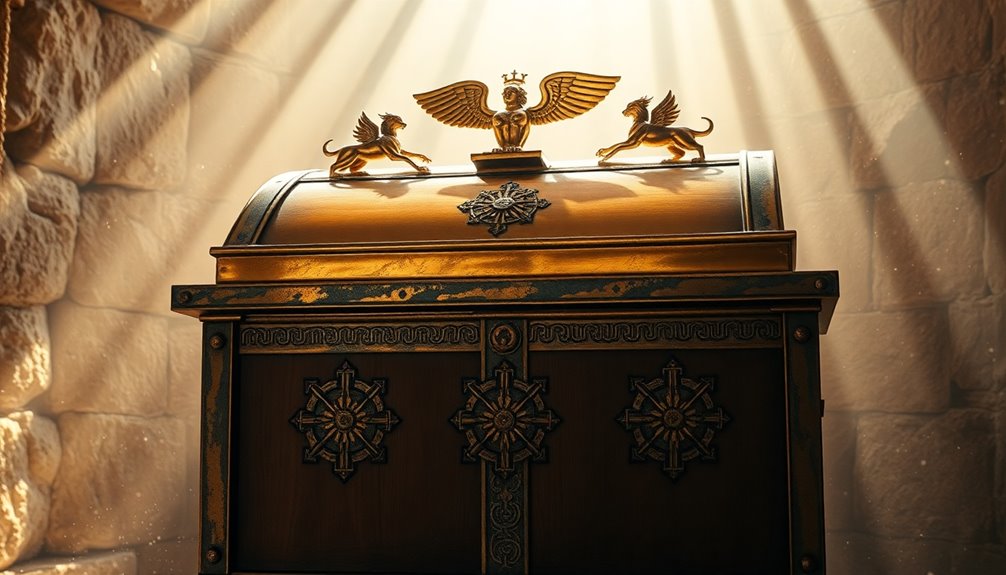The Ark of the Covenant is a sacred chest that symbolizes the relationship between God and the Israelites. It housed the Ten Commandments and played a central role in their worship. You'd find this divine artifact leading the people during significant events, like crossing the Jordan River. Only the High Priest could approach it, emphasizing its sanctity. After it vanished from history around 586 BCE, various theories emerged about its fate, like its possible location in Ethiopia or beneath the Temple Mount. There's so much more to uncover about its historical and cultural significance that's worth exploring.
Key Takeaways
- The Ark of the Covenant symbolizes the divine covenant between God and the Israelites, housing the Ten Commandments and other sacred items.
- It was central to ancient Israelite worship, accessed only by the High Priest on Yom Kippur for atonement rituals.
- The Ark served as a physical manifestation of God's presence, guiding the Israelites during their 40 years of desert wandering.
- Its last known location remains a mystery, with theories suggesting it may be hidden beneath the Temple Mount or in Ethiopia.
- The Ark has inspired various cultural representations and narratives, influencing religious art, literature, and modern popular culture.
Introduction
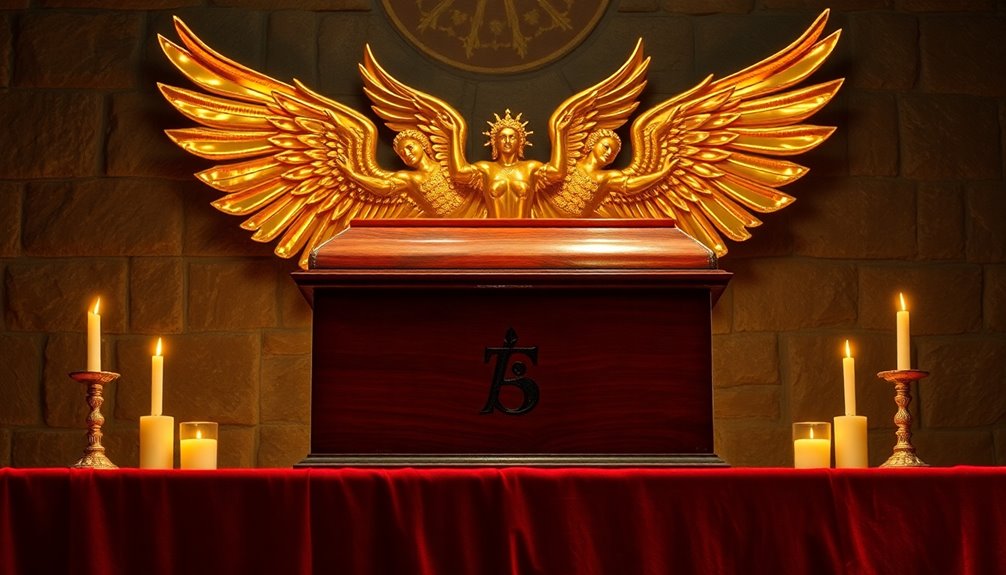
The Ark of the Covenant stands as one of the most significant artifacts in biblical history, representing the intimate relationship between God and the Israelites. Constructed under Moses' divine instructions at Mount Sinai, this gold-plated wooden chest housed the two tablets of the Ten Commandments, serving as a powerful symbol of God's covenant. The Ark wasn't just a container; it embodied God's presence among His people.
During the Israelites' 40 years of desert wandering, the Ark led the way, guiding them through battles and trials. Its presence was pivotal during events like the fall of Jericho, where it demonstrated God's might.
After being captured by the Philistines, the Ark returned to Israel, bringing with it a series of plagues that underscored its divine power and importance.
Ultimately, the Ark's fate remains shrouded in mystery following the destruction of the First Temple in 586 BCE. Various theories suggest it was hidden to protect it from capture, leaving you to ponder the significance it held and the legacy it left behind in the annals of biblical history.
The Ark of the Covenant truly encapsulates a profound connection between God and His chosen people.
Biblical Covenant Significance

When you explore the significance of the Ark of the Covenant, you'll find it deeply tied to primary and secondary biblical references.
These scriptures not only highlight God's promises but also illustrate the expectations He set for His people.
Understanding these connections can enhance your grasp of the covenant's role in Israelite history and faith.
Primary Bible References
Often regarded as the most significant artifact in the Israelite faith, the Ark of the Covenant embodies the profound covenantal relationship between God and His people. Defined in Exodus 25:10-22, the Ark is a wooden chest overlaid with gold, specifically designed to hold the two tablets of the Law given to Moses. These tablets represent God's covenant with the Israelites, serving as a reminder of His expectations and guidance.
The Ark, also known as the Ark of the Testimony, contains not just the tablets, but also Aaron's rod that budded and a pot of manna, as noted in Hebrews 9:4. This emphasizes God's provision and leadership throughout their journey.
The Ark was a physical manifestation of God's Presence, leading the Israelites during their desert wanderings and playing a vital role in their military campaigns, as seen in Joshua 3:3-17 when they crossed the Jordan River.
Access to the Ark was highly restricted, with only the high priest allowed to enter the Holy of Holies on Yom Kippur, as outlined in Leviticus 16:2. This underscores the sacredness of the Ark and the seriousness of the covenant relationship with God.
Secondary Bible References
Many believers recognize the Ark of the Covenant as a powerful symbol of God's covenant with the Israelites. This sacred container housed the two Tablets of the Ten Commandments, representing God's laws and guidance. In Hebrews 9:4, the Ark also contains Aaron's rod and a jar of manna, highlighting God's provision and authority.
During the annual Day of Atonement, the high priest entered the Holy of Holies, where the Ark resided, seeking atonement for the people's sins in God's Presence.
The Ark's significance didn't stop in the Old Testament. When King Solomon built the temple, he placed the Ark in the innermost sanctuary, reinforcing its central role in Israel's spiritual life.
However, prophetic references like Jeremiah 3:16 indicate a shift in understanding God's covenant. The Ark would no longer symbolize God's presence in the future, pointing toward a more spiritual interpretation.
In the New Testament, the Ark is seen as a foreshadowing of Jesus Christ. Mary, who bore the divine presence, is likened to the Ark, emphasizing the continuity of God's covenant relationship with humanity.
This deeper understanding enriches your grasp of the Ark's significance in both testaments.
Ancient Israelite Worship Practices
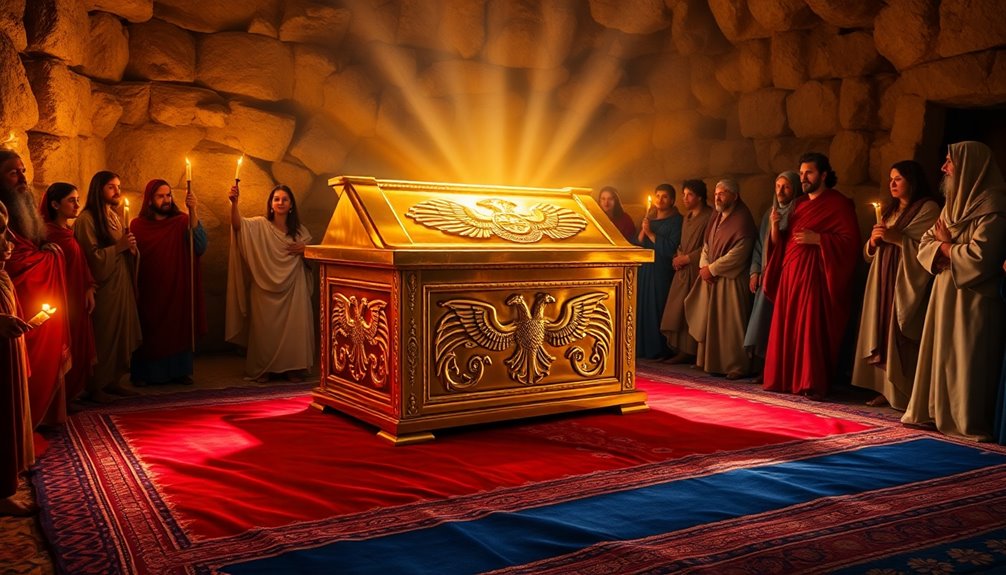
At the heart of Ancient Israelite worship practices lay the Ark of the Covenant, a powerful symbol of God's presence among His people. The Ark was central to rituals and sacrifices in both the Tabernacle and the later Temple. Only the High Priest could enter the Holy of Holies, where the Ark was housed, once a year on Yom Kippur to perform atonement rituals, including sprinkling blood on the mercy seat.
Carrying the Ark was a serious task, entrusted to the Levites, who used poles inserted through rings on its sides. Directly touching the Ark was forbidden and considered fatal, emphasizing the sanctity of this sacred object.
Rituals involving the Ark included grand processions during significant events, such as the crossing of the Jordan River and the siege of Jericho, where it was carried around the city as part of the conquest.
The contents of the Ark, including the Tablets of the Law, Aaron's rod, and a pot of manna, were integral to ancient Jewish identity and worship, representing God's covenant and miraculous provision.
Through these practices, the Israelites reinforced their relationship with God and acknowledged His enduring presence among them.
Symbol of Divine Presence

The Ark of the Covenant stands as a profound symbol of God's divine presence among the Israelites, embodying His commitment to guide and protect them. Constructed from acacia wood and overlaid with gold, the Ark features a mercy seat flanked by two cherubim, creating a sacred space where God communicated with Moses. This remarkable design signifies the intimate relationship between the divine and His people.
As you delve into its significance, you'll find that the Ark served as a powerful reminder of the covenant God made with the Israelites. Inside, it contained the stone tablets of the Ten Commandments, Aaron's rod, and a pot of manna, all representing God's law and provision.
During the Israelites' journey through the wilderness, the Ark led them forward, reinforcing the belief in divine guidance and protection in battle.
Placed in the Holy of Holies within the First Temple built by King Solomon, the Ark was accessible only to the high priest once a year on Yom Kippur. This exclusive access highlights its role as the ultimate symbol of holiness, underscoring God's ongoing divine presence among His chosen people.
Ark's Physical Location Today
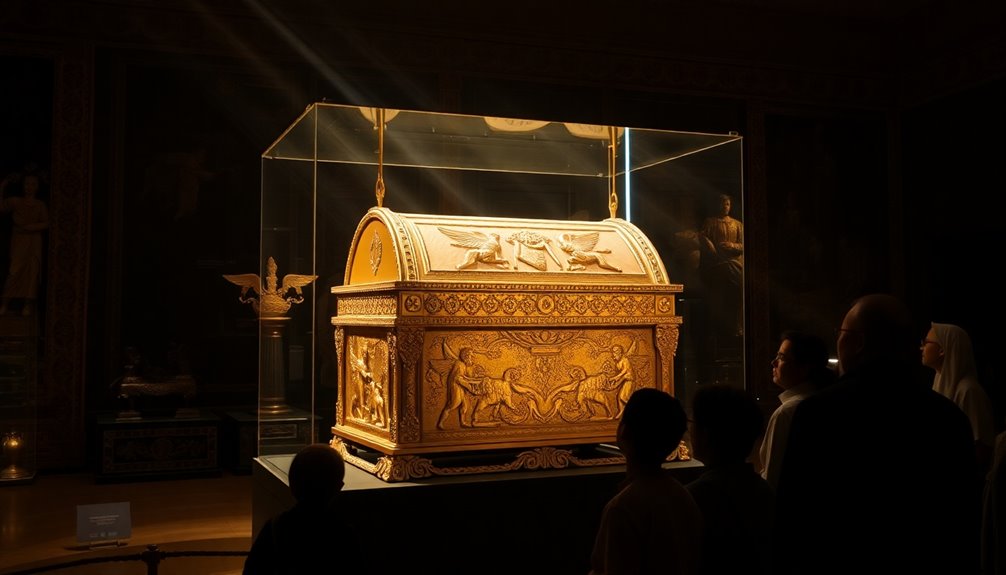
You might think you know where the Ark of the Covenant is today, but many misconceptions surround its fate.
Historical accounts suggest it vanished during King Josiah's reign, and various theories propose it could be hidden in places like Mount Nebo or even in Ethiopia.
Let's explore these claims and the debates over their accuracy.
Debunk Common Misconceptions
Many people mistakenly believe they know the Ark of the Covenant's current location, often citing various claims without solid evidence. The last mentioned reference to the Ark appears during King Josiah's reign, and after the Temple's destruction in 586 BCE, its fate remains a mystery.
Some theories suggest the Ark was hidden by Jeremiah or other priests to protect it from Babylonian capture, but concrete evidence supporting these claims is lacking.
Ethiopian Christians assert the Ark resides in the Church of Saint Mary of Zion in Axum, where a monk known as the Keeper of the Ark is said to guard it.
However, no archaeological evidence has definitively confirmed the location of the Ark since its last known whereabouts. Furthermore, political and religious sensitivities surrounding sites like the Temple Mount hinder archaeological investigations, casting further doubt on any claims about its physical location today.
Historical Accuracy Debates
After addressing common misconceptions about the Ark of the Covenant, it's clear that debates over its historical accuracy and current location are far from settled.
The last known reference to the Ark was during King Josiah's reign, after which it seemingly vanished from historical records. This absence has sparked various theories regarding its fate. Many believe the Ark was hidden to protect it from Babylonian forces during the sack of Jerusalem in 586 BCE, with potential hiding spots including caves near the Dead Sea.
Some Ethiopian Christians assert that they possess the Ark, claiming it resides in the Church of Saint Mary of Zion in Axum, taken there by Menelik, the son of Solomon and the Queen of Sheba.
Meanwhile, archaeologist Leen Ritmeyer suggests the Ark may lie beneath the Temple Mount in Jerusalem, although political and religious sensitivities complicate archaeological efforts.
Conflicting rabbinic traditions further muddle the debate, with some suggesting the Ark was hidden before the Second Temple period, while others recount Jeremiah hiding it in a cave on Mount Nebo.
Each theory adds to the intrigue surrounding this ancient artifact.
Sacred Object in Worship
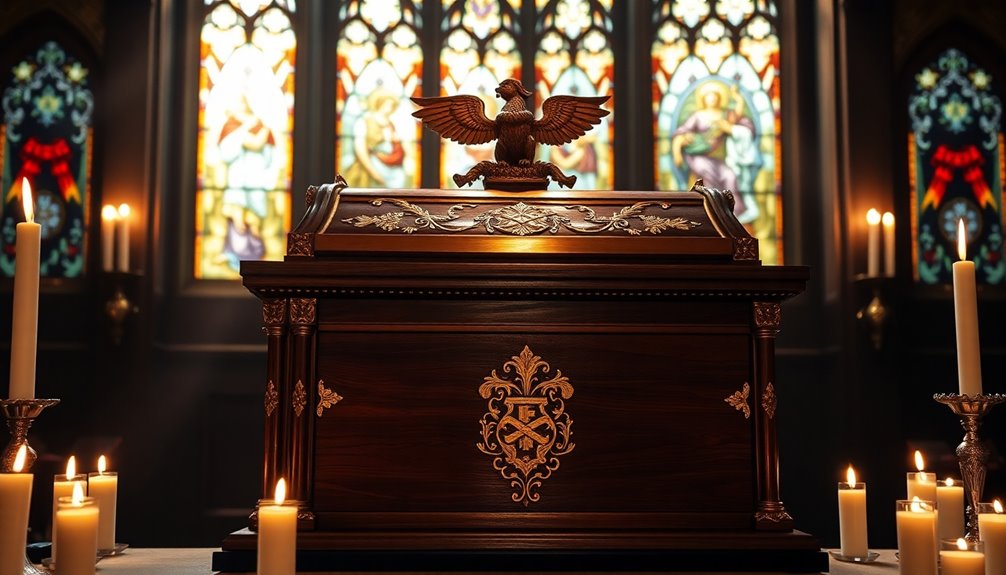
When you think about the Ark of the Covenant, consider how it not only symbolizes personal faith but also fosters community worship.
Its presence during rituals strengthens your commitment to the divine and unites those around you.
The Ark serves as a powerful reminder of shared beliefs and collective spiritual engagement.
Personal Faith and Commitment
The Ark of the Covenant stands as a profound symbol of personal faith and commitment, embodying the sacred relationship between God and the Israelites. This sacred object, constructed from acacia wood and overlaid with gold, housed the Ten Commandments, serving as a constant reminder of the covenant between God and His people. When you think about the Ark, you can sense God's Presence, guiding and supporting the Israelites during their journey through the wilderness.
Only the Levites could carry the Ark, emphasizing the importance of reverence and the strict regulations surrounding it. This act wasn't just about transport; it was an expression of their faith and commitment to uphold the sanctity of God's commands.
On Yom Kippur, the High Priest approached the Mercy Seat atop the Ark, performing rituals of atonement that represented repentance and reconciliation with God. This annual event deepened the personal connection individuals felt toward their faith, reinforcing their commitment to the covenant.
Ultimately, the Ark encapsulates the essence of your relationship with God—a reminder that personal faith and commitment are vital in nurturing your spiritual journey and maintaining a sacred bond with the divine.
Community Worship Engagement
In ancient Israel, the Ark of the Covenant became a central focus in community worship, symbolizing God's presence among His people. The Ark wasn't just a sacred object; it represented the very essence of their faith and unity. When you think about the Israelites wandering in the desert, you can imagine how crucial it was for them to engage in community worship centered around the Ark.
During significant events, the priests carried the Ark, leading the way into battles and across the Jordan River, showcasing the collective faith of the community. This act emphasized that God's presence wasn't just an individual experience; it was a shared journey.
The tent of meeting housed the Ark, providing a sacred space where the community could come together to seek guidance and atonement. The rituals surrounding the Ark reinforced the importance of reverence in worship. Only the High Priest could enter the Holy of Holies once a year, underscoring the sacredness of this object.
Cultural Impact of the Ark
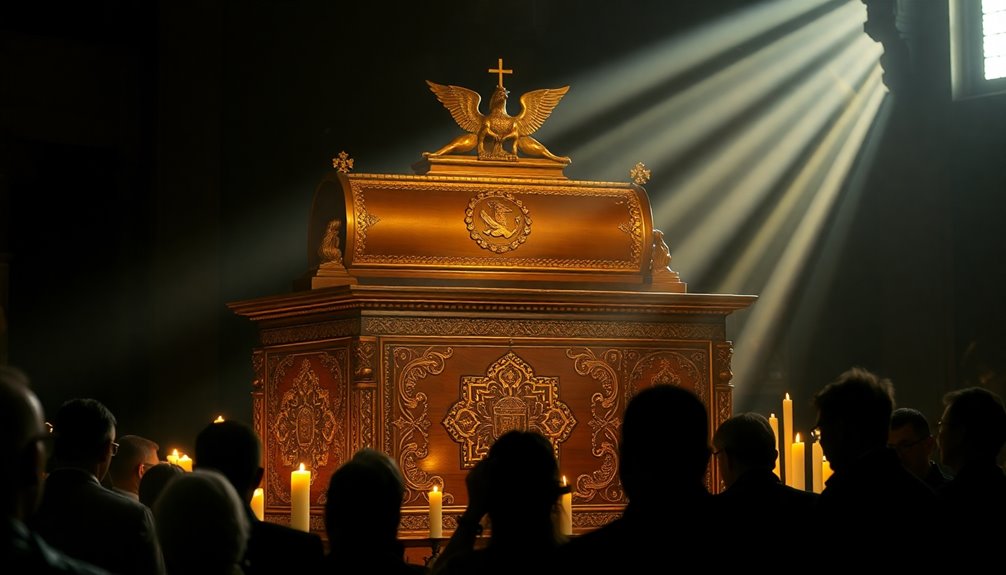
Throughout history, the Ark of the Covenant has left a profound mark on religious art and literature, symbolizing faith, obedience, and divine guidance for millions.
You'll find its themes woven through sacred texts, from the Hebrew Bible to the New Testament and even the Quran, showcasing its importance across different cultures. The Ark serves as a representation of God's Presence, embodying the connection between humanity and the divine.
When the Philistines took the Ark, it sparked narratives filled with spiritual tension and cultural significance, influencing how people viewed worship in relation to the temple.
This story has inspired countless artistic representations and literary works, fueling your imagination about its power and mystery.
In modern culture, films like "Indiana Jones and the Raiders of the Lost Ark" have amplified its mystique, making it a symbol of adventure and divine wrath.
As interest in the Ark continues, various claims about its whereabouts—especially from Ethiopian Christians—keep the conversation alive, enhancing its cultural legacy.
The ongoing quest for the Ark invites you to ponder its spiritual and historical implications, bridging the past with contemporary beliefs.
Additional Resources

Exploring the Ark of the Covenant opens up a wealth of resources for deeper understanding. To dive into its significance, you might start with the Old Testament, particularly the books of Exodus and Joshua, where the Ark's construction and pivotal role during the Israelites' desert wanderings are detailed.
You'll find that the Ark, made of acacia wood and overlaid with gold, housed the Ten Commandments—symbolizing the covenant between God and His people.
Researching King David's efforts to bring the Ark to Jerusalem adds another layer of insight. You'll discover how it was placed in Solomon's Temple, specifically in the Holy of Holies, a sacred space emphasizing God's Presence among His people.
For more in-depth exploration, consider scholarly articles that discuss theories surrounding the Ark's fate after the Babylonian destruction of Jerusalem in 586 BCE.
You can also look into legends claiming its current location, like Ethiopia's Church of Saint Mary of Zion. These resources will deepen your appreciation of the Ark's historical, cultural, and spiritual significance within the biblical narrative.
Frequently Asked Questions
Where Is Ark of Covenant Now?
You might wonder where ancient artifacts end up after their last known locations.
Historians often speculate on their fates, suggesting they could be hidden, destroyed, or even lost to time.
Some believe they might be concealed in tunnels or caves, while others claim they're preserved in sanctuaries.
With competing theories and a lack of definitive evidence, it's no surprise that the search for such treasures fuels your curiosity and imagination.
What Is Inside the Ark of the Covenant?
Inside the chest, you'll find three significant items.
First, there are the two stone tablets inscribed with the Ten Commandments, representing God's laws.
Next, there's a jar of manna, symbolizing God's provision during tough times.
Finally, you'll see Aaron's rod, which miraculously budded, signifying divine leadership among the people.
Each item holds profound meaning, reflecting the relationship between God and His chosen people throughout their journey.
Why Can't You Open the Ark of the Covenant?
You can't open it because it's considered extremely sacred.
The reverence surrounding it stems from the belief that tampering with something so holy could lead to dire consequences.
Only specific individuals are allowed to be near it, and even then, strict rules prevent direct contact.
The sanctity attached to it reflects a divine law that maintains a barrier between the ordinary and the sacred, emphasizing the importance of respecting spiritual boundaries.
When Was the Last Time the Ark of the Covenant Was Seen?
The last recorded sighting of the object in question dates back to the reign of King Josiah, around 640-609 BCE.
After that, it vanished from historical accounts, leaving you wondering about its fate.
Various traditions suggest it was hidden to avoid capture during the Babylonian conquest in 586 BCE.
Unfortunately, despite extensive searches, you won't find any definitive evidence of its whereabouts since that time, which adds to the mystery surrounding it.

